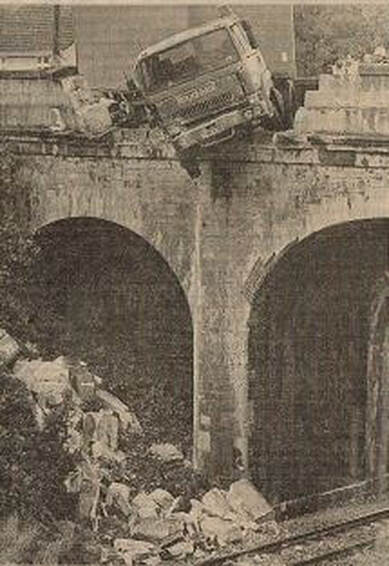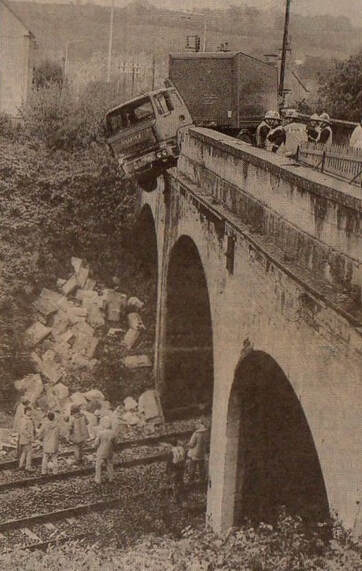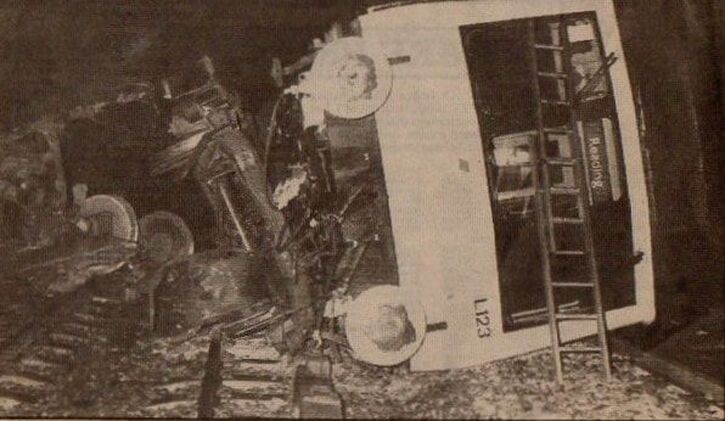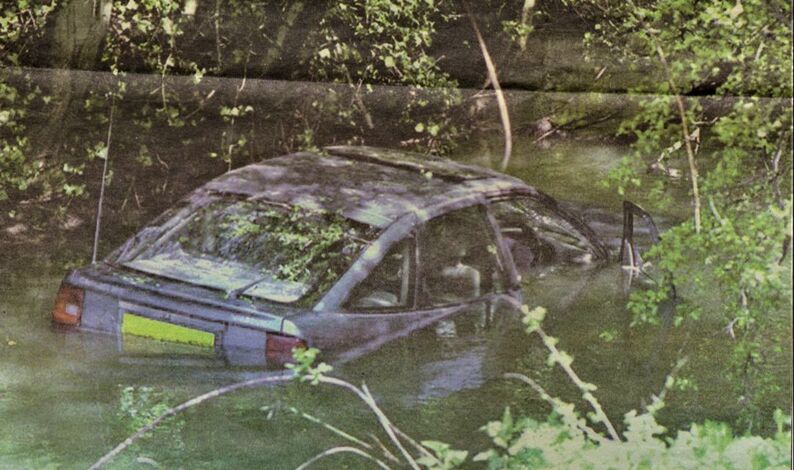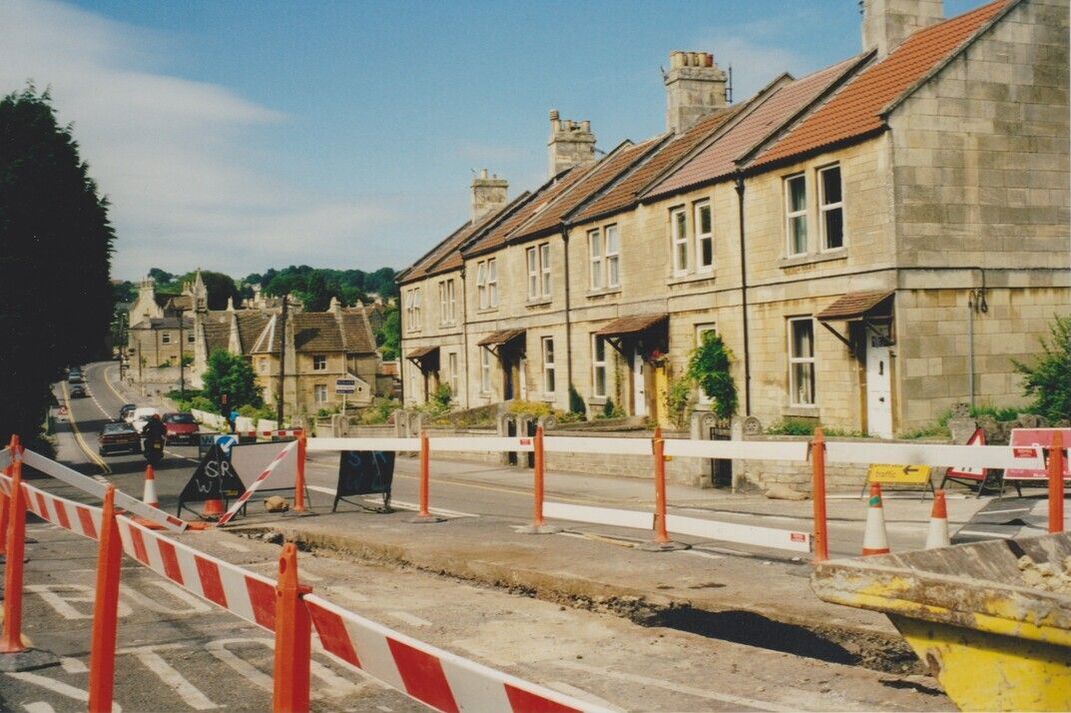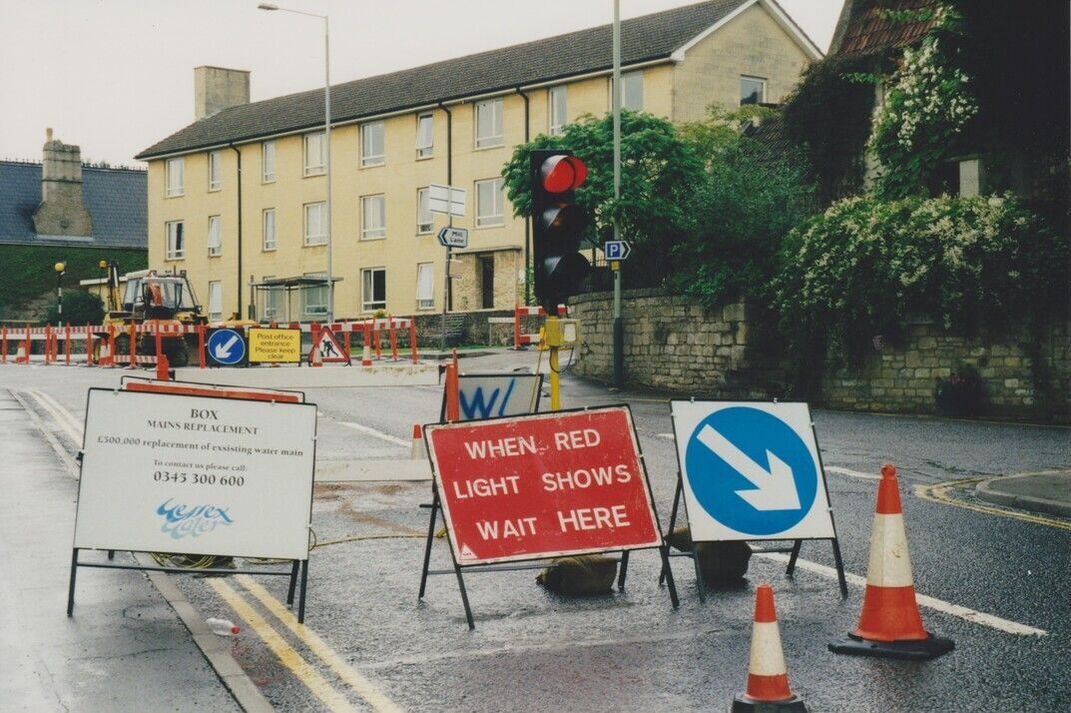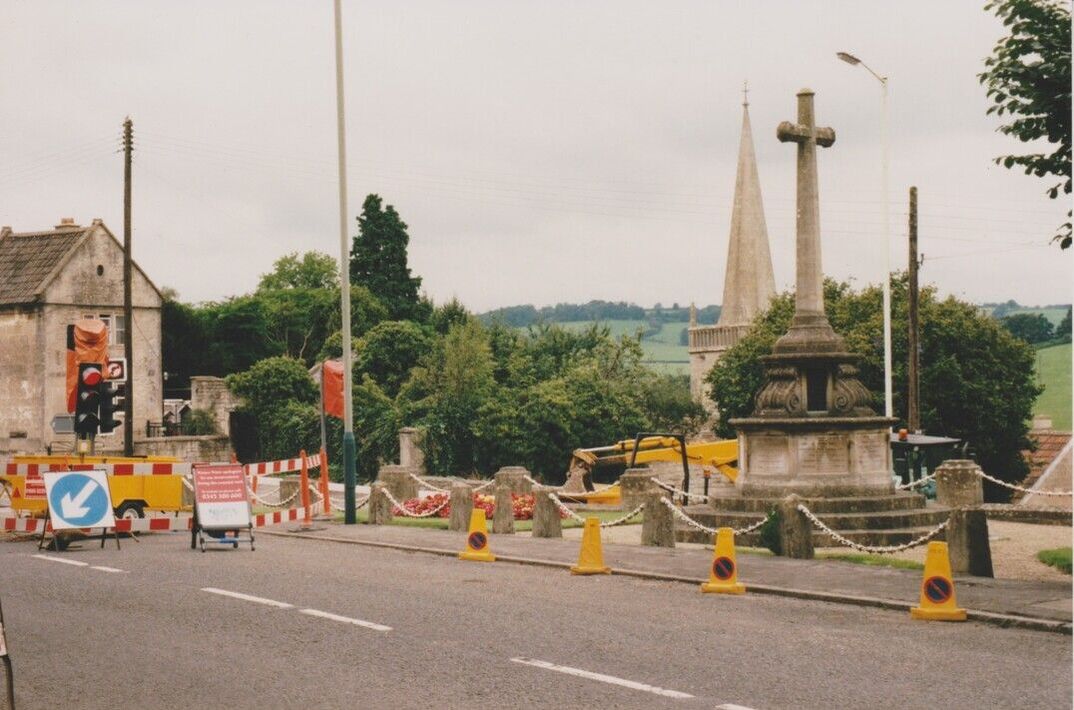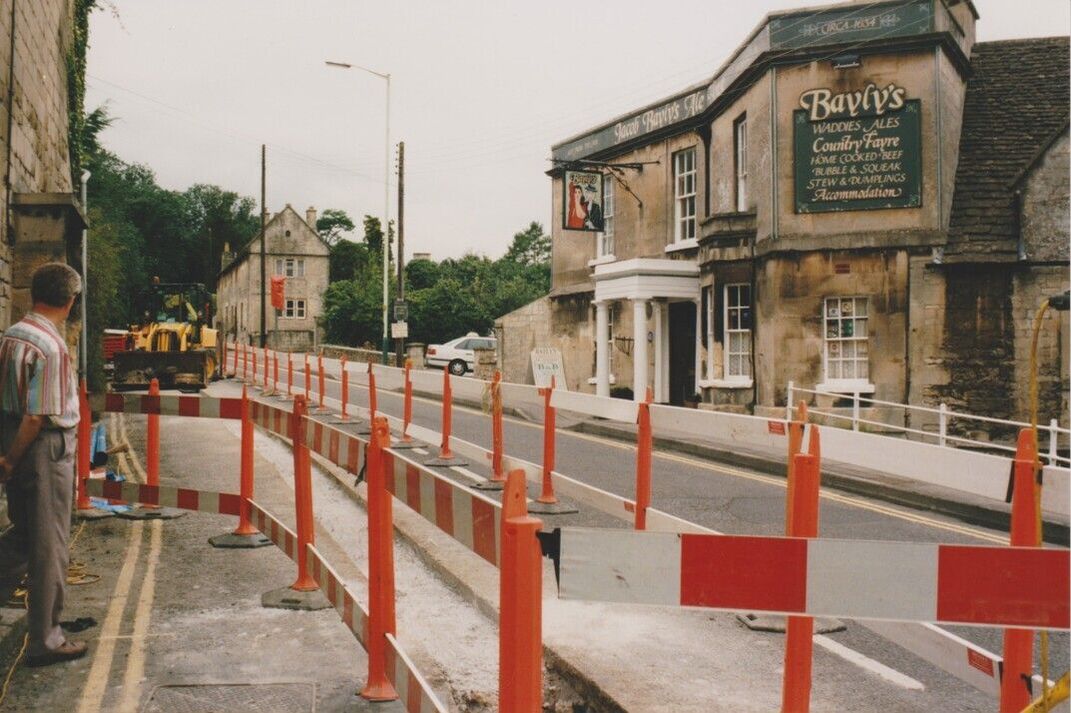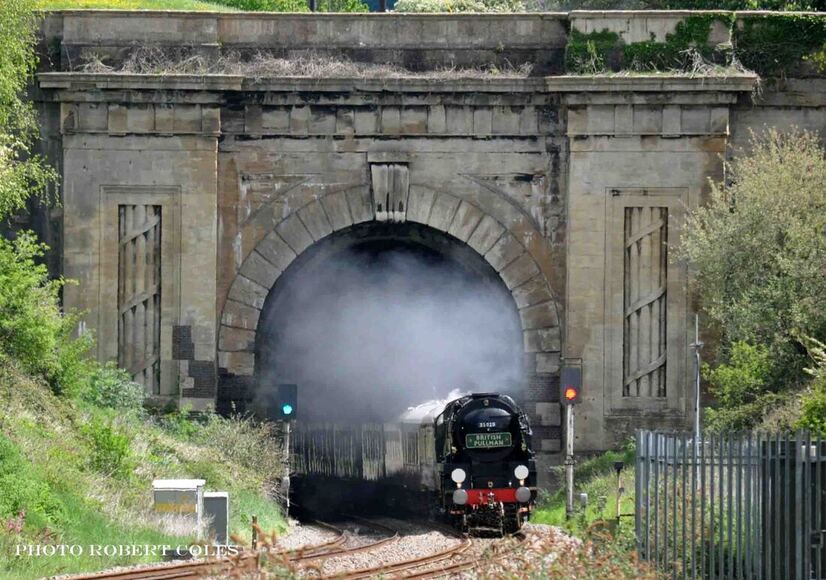Cars and Trains Alan Payne November 2023
Two views of the Post Office lorry on Box Tunnel Bridge Left: courtesy Western Daily Press, 30 October 1989 and
Right: Bath and Wilts Evening Chronicle, 29 October 1989
Right: Bath and Wilts Evening Chronicle, 29 October 1989
Much as we deplore it, for many people outside the village, Box is today chiefly known for its traffic, often congested along the High Street. It has become a place to drive through or, at best, to pause to admire the Box Tunnel usually seen briefly when driving past. Few outsiders know of the Roman Villa or of the huge number of Georgian listed buildings. It has to be said that one of the worse features of living in Box is trying to cross the A4 on foot at rush hours. Traffic has become part of our modern lives.
Road Crash, 1989
Whenever an arterial road is closed it causes inevitable problems as there are so few alternative routes. It is even worse when train and rail links intersect. This caused serious problems in October 1989 when a lorry crashed on the Box Tunnel Bridge scattering debris on the rail line below. The evening newspapers reported the accident saying that at 10am on 29 October 1989 road and rail came into collision with dramatic results.[1] It was later reported that the train came within inches of disaster.[2] The incident started when a motor-cyclist caused a Post Office lorry to crash head-on into a car at Box Tunnel Bridge. The lorry smashed through the parapet of the bridge bringing debris down onto the track. There was insufficient time to stop a Paddington to Penzance express train which then ploughed into the wreckage and derailed. Fortunately, there were no serious injuries amongst the 300 passengers or train staff. The train engine was replaced and it was able to continue and the line cleared after six hours.
The road was re-opened later that day and temporary traffic lights installed to stop two-way traffic. By November that year the County Council wanted to remove the lights, greatly against the wishes of the Parish Council under chair Margaret Rousell who thought that they were needed to slow traffic through the centre.[3] Eventually, the County agreed to raise the height of the kerb, to paint white lines on the side and to install a crash barrier. Not much sign of that now!
Road Crash, 1989
Whenever an arterial road is closed it causes inevitable problems as there are so few alternative routes. It is even worse when train and rail links intersect. This caused serious problems in October 1989 when a lorry crashed on the Box Tunnel Bridge scattering debris on the rail line below. The evening newspapers reported the accident saying that at 10am on 29 October 1989 road and rail came into collision with dramatic results.[1] It was later reported that the train came within inches of disaster.[2] The incident started when a motor-cyclist caused a Post Office lorry to crash head-on into a car at Box Tunnel Bridge. The lorry smashed through the parapet of the bridge bringing debris down onto the track. There was insufficient time to stop a Paddington to Penzance express train which then ploughed into the wreckage and derailed. Fortunately, there were no serious injuries amongst the 300 passengers or train staff. The train engine was replaced and it was able to continue and the line cleared after six hours.
The road was re-opened later that day and temporary traffic lights installed to stop two-way traffic. By November that year the County Council wanted to remove the lights, greatly against the wishes of the Parish Council under chair Margaret Rousell who thought that they were needed to slow traffic through the centre.[3] Eventually, the County agreed to raise the height of the kerb, to paint white lines on the side and to install a crash barrier. Not much sign of that now!
Car Crashes
Since the closure of Box Station and Mill Lane Halt in 1965., traffic through the village has worsened. Without a rail station there is very often no alternative but to use buses or private cars. Deregulation of bus services after 1985 also impacted road usage.
Fortunately, most road collisions aren’t fatal due to seat belts and better car impact protection. Some have even been rather amusing, such as the incident in May 1997.[4] The car swerved off the road at the GWR Box Bridge at the dog-leg of the A4 and Ashley Lane, and the vehicle ended in the By Brook where it quickly became submerged. The driver from Malmesbury shouted that he couldn’t swim. Mrs Georgette McCready of 3 Mead Villas, Box, was driving past and bravely went to his aid. She stayed with him until ladders could be brought as the banks were too steep to climb out.
Strangely the boundary post at the bridge is a significant structure and is listed as an historic building, It was described in 1985 as: Boundary Post, dated 1835, cast-iron, triangular section with 'Bath Turnpike Trust' on leading edge, 'Bathford' on west side and 'Box' on east side. Half buried.
Since the closure of Box Station and Mill Lane Halt in 1965., traffic through the village has worsened. Without a rail station there is very often no alternative but to use buses or private cars. Deregulation of bus services after 1985 also impacted road usage.
Fortunately, most road collisions aren’t fatal due to seat belts and better car impact protection. Some have even been rather amusing, such as the incident in May 1997.[4] The car swerved off the road at the GWR Box Bridge at the dog-leg of the A4 and Ashley Lane, and the vehicle ended in the By Brook where it quickly became submerged. The driver from Malmesbury shouted that he couldn’t swim. Mrs Georgette McCready of 3 Mead Villas, Box, was driving past and bravely went to his aid. She stayed with him until ladders could be brought as the banks were too steep to climb out.
Strangely the boundary post at the bridge is a significant structure and is listed as an historic building, It was described in 1985 as: Boundary Post, dated 1835, cast-iron, triangular section with 'Bath Turnpike Trust' on leading edge, 'Bathford' on west side and 'Box' on east side. Half buried.
Quieter Times in 1997
From April to September 1997, the High Street in Box had significant traffic restrictions while Wessex Water replaced the water mains in Box and up Box Hill. Wessex Water identified considerable variations in water pressure which caused severe leakages. The original pipes had been installed about 1910 with reports that only a single water main (ran) from Rudloe Tower reservoir feeding Box village. The total cost of the project was quoted as £500,000 with the possibility that the sewers at Bargates and the High Street were showing defects which could lead to their collapse. This would be dealt with at a later date if their collapse caused flooding or pollution.
From April to September 1997, the High Street in Box had significant traffic restrictions while Wessex Water replaced the water mains in Box and up Box Hill. Wessex Water identified considerable variations in water pressure which caused severe leakages. The original pipes had been installed about 1910 with reports that only a single water main (ran) from Rudloe Tower reservoir feeding Box village. The total cost of the project was quoted as £500,000 with the possibility that the sewers at Bargates and the High Street were showing defects which could lead to their collapse. This would be dealt with at a later date if their collapse caused flooding or pollution.
Above and below: Images of Box roads during the extensive road works in the summer of 1997 (courtesy Angela Oliver)
Remembering Our Transport History
We don't have to despair of our road congestion because transport alters constantly. Steam engines on our railway line are now so rare that they are historic occasions to be celebrated. This magnificent photograph by Robert Coles (below) was taken on Wednesday 19 May 2021. It was the first run of the Belmond British Pullman to Bath for more than a year and very unusually the train from Victoria joined the main line at Reading. The Locomotive was Merchant Navy Class rebuilt Bulleid Pacific, 35028 Clan Line.
Robert told us about his picture: I had always wanted a photo of the west portal of Middlehill Tunnel and I thought I would arrive in Box early and have a scout around. The photo was taken from the old station yard. Looking up to the tunnel mouth I could see something moving, a small group of sheep were exercising their well know suicide instinct. I didn’t know what to do - ring the emergency rail number which would cause disruption or ignore and hope the sheep would go away by the time a train passed.
I decided to phone and, as I was doing so, a couple of regular trains passed. By then, the sheep had found their way to a new field and were no longer on the line. Panic over and I took the photo before driving to the farm to tell the farmer that he had loco spotting sheep.
We don't have to despair of our road congestion because transport alters constantly. Steam engines on our railway line are now so rare that they are historic occasions to be celebrated. This magnificent photograph by Robert Coles (below) was taken on Wednesday 19 May 2021. It was the first run of the Belmond British Pullman to Bath for more than a year and very unusually the train from Victoria joined the main line at Reading. The Locomotive was Merchant Navy Class rebuilt Bulleid Pacific, 35028 Clan Line.
Robert told us about his picture: I had always wanted a photo of the west portal of Middlehill Tunnel and I thought I would arrive in Box early and have a scout around. The photo was taken from the old station yard. Looking up to the tunnel mouth I could see something moving, a small group of sheep were exercising their well know suicide instinct. I didn’t know what to do - ring the emergency rail number which would cause disruption or ignore and hope the sheep would go away by the time a train passed.
I decided to phone and, as I was doing so, a couple of regular trains passed. By then, the sheep had found their way to a new field and were no longer on the line. Panic over and I took the photo before driving to the farm to tell the farmer that he had loco spotting sheep.
In past ages, roads were for people and animals; now they exist mainly for cars and motor traffic and pedestrians survive by staying on the pavement. The growth of car numbers led to many road alterations and it seems incredible that Box Fiveways traffic lights were only installed in 1997 after several serious crashes.[6] What wouldn't we give for a railway station and first class bus service in the area to reduce car usage.
References
[1] Bath and Wilts Evening Chronicle, 29 October 1989
[2] Western Daily Press, 30 October 1989
[3] Chippenham News, 2 November 1990
[4] The Bath Chronicle, 26 May 1997
[5] Wessex Water leaflet issued 4 April 1997
[6] Parish Magazine, March 1997
[1] Bath and Wilts Evening Chronicle, 29 October 1989
[2] Western Daily Press, 30 October 1989
[3] Chippenham News, 2 November 1990
[4] The Bath Chronicle, 26 May 1997
[5] Wessex Water leaflet issued 4 April 1997
[6] Parish Magazine, March 1997
